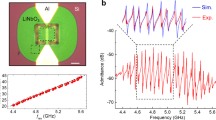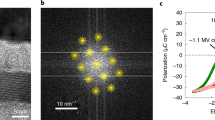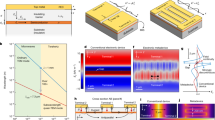Abstract
Electromechanical resonators operating in the sub-terahertz regime could be of use in the development of future communication systems because they support extremely fast data rates. Such resonators are also of interest in studying quantum phenomena of mechanical entities, as they can maintain the quantum ground state at kelvin temperatures rather than the millikelvin temperatures demanded by gigahertz resonators. Here we report microelectromechanical resonators operating beyond 100 GHz. By incorporating a millimetre-wave dual-rail resonator into a thickness-shear-mode micromechanical system, we achieve efficient electromechanical transduction through enhanced on-chip impedance matching, which is key to revealing the infinitesimal displacements of these sub-terahertz mechanical modes. Our devices are based on commercially available z-cut lithium niobate thin films and patterned using standard semiconductor fabrication processes.
This is a preview of subscription content, access via your institution
Access options
Access Nature and 54 other Nature Portfolio journals
Get Nature+, our best-value online-access subscription
$29.99 / 30 days
cancel any time
Subscribe to this journal
Receive 12 digital issues and online access to articles
$119.00 per year
only $9.92 per issue
Buy this article
- Purchase on Springer Link
- Instant access to full article PDF
Prices may be subject to local taxes which are calculated during checkout




Similar content being viewed by others
Data availability
The data that support the findings of this study are included in this Article. Source data are provided with this paper.
References
O’Connell, A. D. et al. Quantum ground state and single-phonon control of a mechanical resonator. Nature 464, 697–703 (2010).
Forstner, S., Zych, M., Basiri-Esfahani, S., Khosla, K. E. & Bowen, W. P. Nanomechanical test of quantum linearity. Optica 7, 1427–1434 (2020).
Ockeloen-Korppi, C. F. et al. Stabilized entanglement of massive mechanical oscillators. Nature 556, 478–482 (2018).
Lin, Q., He, B. & Xiao, M. Entangling two macroscopic mechanical resonators at high temperature. Phys. Rev. Appl. 13, 034030 (2020).
Han, X., Fu, W., Zou, C.-L., Jiang, L. & Tang, H. X. Microwave-optical quantum frequency conversion. Optica 8, 1050–1064 (2021).
Henry Huang, X. M., Zorman, C. A., Mehregany, M. & Roukes, M. L. Nanodevice motion at microwave frequencies. Nature 421, 496–496 (2003).
Chu, Y. et al. Quantum acoustics with superconducting qubits. Science 358, 199–202 (2017).
Satzinger, K. J. et al. Quantum control of surface acoustic-wave phonons. Nature 563, 661–665 (2018).
Forsch, M. et al. Microwave-to-optics conversion using a mechanical oscillator in its quantum ground state. Nat. Phys. 16, 69–74 (2020).
Mirhosseini, M., Sipahigil, A., Kalaee, M. & Painter, O. Superconducting qubit to optical photon transduction. Nature 588, 599–603 (2020).
Merlin, R. Generating coherent THz phonons with light pulses. Solid State Commun. 102, 207–220 (1997).
Thomsen, C., Grahn, H. T., Maris, H. J. & Tauc, J. Surface generation and detection of phonons by picosecond light pulses. Phys. Rev. B 34, 4129 (1986).
Esmann, M. et al. Brillouin scattering in hybrid optophononic Bragg micropillar resonators at 300 GHz. Optica 6, 854–859 (2019).
Shen, M. et al. High frequency lithium niobate film-thickness-mode optomechanical resonator. Appl. Phys. Lett. 117, 131104 (2020).
Yang, Y., Lu, R., Gao, L. & Gong, S. 10–60-GHz electromechanical resonators using thin-film lithium niobate. IEEE Trans. Microw. Theory Techn. 68, 5211–5220 (2020).
Kemiktarak, U., Ndukum, T., Schwab, K. C. & Ekinci, K. L. Radio-frequency scanning tunnelling microscopy. Nature 450, 85–88 (2007).
Larson, J. D., Bradley, P. D., Wartenberg, S. & Ruby, R. C. Modified Butterworth-Van Dyke circuit for FBAR resonators and automated measurement system. In 2000 IEEE Ultrasonics Symposium. Proceedings. An International Symposium (Cat. No.00CH37121) 1, 863–868 (IEEE, 2000).
Anferov, A., Suleymanzade, A., Oriani, A., Simon, J. & Schuster, D. I. Millimeter-wave four-wave mixing via kinetic inductance for quantum devices. Phys. Rev. Appl. 13, 024056 (2020).
Faramarzi, F. et al. Initial design of a W-band superconducting kinetic inductance qubit. IEEE Trans. Appl. Supercond. 31, 1800605 (2021).
Poberaj, G., Hu, H., Sohler, W. & Guenter, P. Lithium niobate on insulator (LNOI) for micro‐photonic devices. Laser Photon. Rev. 6, 488–503 (2012).
Williams, D. F., and R. B. Marks. Compensation for substrate permittivity in probe-tip calibration. In 44th ARFTG Conference Digest 26, 20–30 (IEEE, 1994).
Acknowledgements
This work is supported by the Army Research Office through grant W911NF-18-1-0020 (H.X.T., M.S., Y.X. and W.F.). H.X.T. acknowledges support from the NSF Center for Quantum Networks under grant no. EEC-1941583 and Department of Energy (DOE) Co-Design Center for Quantum Advantage (C2QA) through grant no. DE-SC0012704. J.X. acknowledges support from NSF under grant no. EFMA-1640959. Funding for materials used for this study is partially provided by the DOE (DE-SC0019406). We thank M. Xu for fruitful discussions. We thank Y. Sun, S. Rinehart, K. Woods and M. Rooks for the assistance in the device fabrication.
Author information
Authors and Affiliations
Contributions
H.X.T. and J.X. conceived the idea. J.X. designed the devices and experiments under the guidance of H.X.T. J.X. fabricated the devices with contributions from M.S., Y.X., W.F. and L.Y. J.X. performed the experiment, processed the data and provided the theoretical analysis. J.X. and H.X.T. wrote the manuscript with input from all the authors. H.X.T. supervised the project.
Corresponding author
Ethics declarations
Competing interests
The authors declare no competing interests.
Peer review
Peer review information
Nature Electronics thanks Zhenyun Qian for their contribution to the peer review of this work.
Additional information
Publisher’s note Springer Nature remains neutral with regard to jurisdictional claims in published maps and institutional affiliations.
Supplementary information
Supplementary Information
Supplementary sections I–V, figs. 1–11, tables 1–6 and references.
Source data
Source Data Fig. 2
Source data for Fig. 2.
Source Data Fig. 3
Source data for Fig. 3.
Source Data Fig. 4
Source data for Fig. 4.
Rights and permissions
Springer Nature or its licensor (e.g. a society or other partner) holds exclusive rights to this article under a publishing agreement with the author(s) or other rightsholder(s); author self-archiving of the accepted manuscript version of this article is solely governed by the terms of such publishing agreement and applicable law.
About this article
Cite this article
Xie, J., Shen, M., Xu, Y. et al. Sub-terahertz electromechanics. Nat Electron 6, 301–306 (2023). https://doi.org/10.1038/s41928-023-00942-y
Received:
Accepted:
Published:
Issue Date:
DOI: https://doi.org/10.1038/s41928-023-00942-y



